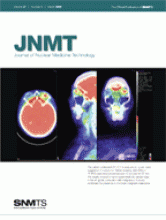
Frances Neagley, CNMT, FSNMTS Editor, JNMT
Here's wishing a happy, belated new year to all of you readers. I hope all of you have survived the winter and the cold and flu season and are now moving into a bright and cheery springtime. This has been a rather quiet winter for me. California had a cold but dry winter, and there is much talk about water rationing this coming summer. On the other hand, the rest of the nation has had an extremely cold, wet, and snowy winter with a lot of major and prolonged power outages. I cannot even imagine what that would be like.
And especially at times like this, when I am procrastinating through multiple tasks, I wonder what it would be like to have weather play such a major role in one's life. Would I be more efficient if I had a snowstorm predicted this afternoon? Would I be rushing to get tasks done before the power fails?
As I write this editorial, I am starting to get ready to attend the SNM annual Mid-Winter Symposium in Clearwater, Florida. I expect it will be warm and humid there; but I do so look forward to seeing the technologists, physicians, and SNM staff who attend each year. When I try to convince technologists about the positive aspects of involvement in the Tech Section, I always stress the camaraderie and networking that comes at these and other meetings.
At so many meetings in the past, however, I could be heard paraphrasing the inaugural speech of President John F. Kennedy—“ask not what the Tech Section can do for you—ask what you can do for the Tech Section.” So it was with great joy that I listened to President Barack Obama's inaugural address, in which he spoke of a “new era of responsibility” for us all. There is so much to be done to keep the Tech Section and the Journal of Nuclear Medicine Technology a vital part of molecular imaging and nuclear medicine technology. I would hope that this year all of us would take an active role on some level in our professional organization.
It certainly would be easy to look at the JNMT and think that it is a pretty good journal and that it has always been sort of small. For me, however, I think about how much better it can be. I have always wanted it to be bigger, that is, have more pages and a higher impact rating. I would like technologists to have a pride of ownership and more involvement in the Journal. I continually approach speakers at scientific meetings and encourage them to publish their presentations in the JNMT.
Thanks to efforts by the staff in the Communications Department, we have recruited more technologists willing to review manuscripts submitted to the JNMT. When I first started as editor of the JNMT, we had about 40 reviewers who identified themselves as CNMT. Now there are 84, but that is still a pretty small number and many of these do not respond to our invitation to review. I think many of the email addresses may not be current. I try not to ask anyone to review more than one or two articles a year, so we always need more reviewers, especially if we are to increase our submissions.
I am really pleased that this issue of the JNMT once again has two continuing education articles—one on infrequently performed studies and the other on pharmacologic stress testing. In addition, there are a number of articles on imaging. The U.S. Nuclear Regulatory Commission has an article in the professional development section in the back.
As always, I urge all of you to read the JNMT, support the Tech Section, and contact me with any ideas you may have about either of these endeavors. My email is fneagley{at}pacbell.net, and I welcome all comments.







